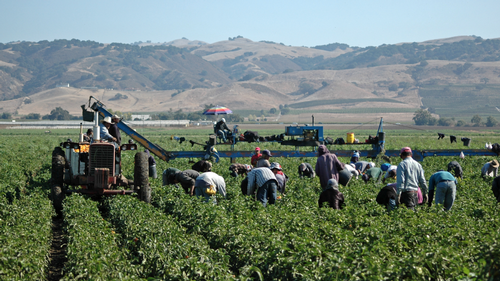Understanding Labor Issues in California Agriculture
Mark here. I'm including below really nice overview of the current ag labor issue in California by colleague Laura Tourte. The intensity of work and dependence of our agriculture on labor here on the Central Coast make this topic really relevant and, given the looming changes in cost and availability, pretty important to understand well.
Growers often report – and researchers generally agree – that labor shortages exist in agriculture along the Central Coast and elsewhere in California, and that labor costs are rising. The reasons are for this situation are complex and multifaceted. Here are some considerations:
- The fresh market crops that dominate agricultural production along the Central Coast are labor intensive. Weeding, pruning and training, irrigation and harvest are examples of practices that are especially labor intensive.
- Labor represents between almost 30 and 60 percent of total production and harvest costs, depending upon the crop and crop cycle. It may be even higher for some crops grown elsewhere in California.
- Labor costs are rising, in part because of changing regulations associated with minimum wage, overtime, health care, paid sick leave and non-productive time, but also because there is a shortage of agricultural labor along with an increased demand for workers.
- Increased labor and production costs can strain and negatively impact the already thin profit margins associated with some crops.
- Immigration constraints and tightened border enforcement have reduced the number of agricultural workers from Mexico—the primary source of labor—that are seeking work in the area and state. The expanding agricultural industry in Mexico has also reduced the number of workers seeking employment here.
- The agricultural labor force is aging and more settled, and have families and other connections to local communities. Because of this, experienced workers do not migrate with the crop production and harvest cycles as often as in the past.
- Most harvest and other labor intensive practices for fresh market crops have not yet been highly mechanized or automated because of important “sensory attributes”—particularly sight and touch—that humans bring to agricultural work. Some commercially available technology already exists, and public and private research efforts are underway to mechanize or automate other labor intensive practices. Mechanical aids are also being used if available, or are being developed, with the goal of improving labor efficiency.
- Some of the area's farmers now supplement their labor forces with foreign guest workers using the federal H-2A program. The program has expanded rapidly in California in recent years increasing from roughly 3,000 certified farm jobs in fiscal year 2012 to 15,000 in fiscal year 2017. However, the program's recruitment process, requirements and associated costs limit it as a viable option for some growers.
- Affordable housing for farm workers is often lacking or constrained. Efforts to address housing issues are in discussion and in progress in the area.
The full impact of labor shortages and rising labor costs is not yet known. The Race in the Fields: Imports, Machines and Migrants, a California Agriculture article by Philip Martin, Professor Emeritus of Agricultural and Resource Economics at UC Davis considers whether current conditions will result in rising imported produce, mechanization, or more foreign guest workers in agriculture. It is also one of the sources of information for this blog article, along with other articles from California Agriculture. http://calag.ucanr.edu/. Cost information is from various cost and return studies, which can be found at https://coststudies.ucdavis.edu.

Farm labor

